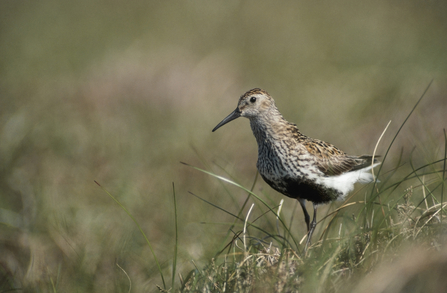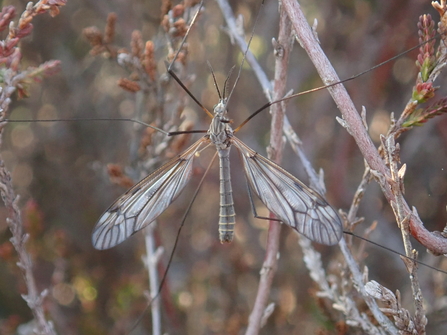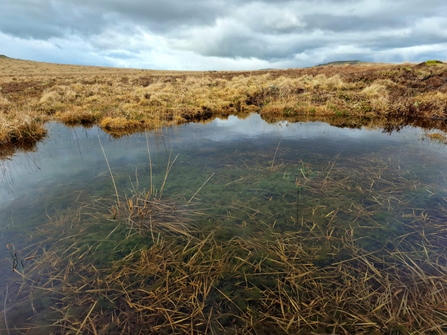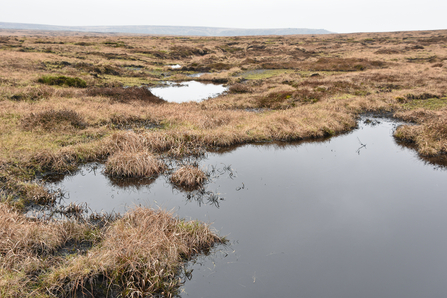Dunlin are migratory birds that breed on upland moors and bogs in the UK and are an important indicator species for peatland health.
A charismatic bird
Dunlin (Calidris alpina) are migratory wading birds. Their global population is estimated to be somewhere between 4 and 7 million individuals, with up to ten different races identified, three of which are known to occur in the UK – alpina, schinzii and arctica. Dunlin are a circumpolar breeder around the Arctic and sub-Arctic regions, and during the winter months can be found throughout Europe, Africa, the Middle East and south-east Asia.
Dunlin in the UK are usually associated with coastlines where they can be seen swirling and whirling in large flocks – in fact they are one of our most common shoreline birds with around 350,000 birds found here each winter. Ringing data from the British Trust for Ornithology (BTO) shows that most of these birds migrate back to their breeding grounds in eastern Europe and Russia in the spring, and are replaced by birds that have spent the winter in Europe and northern Africa. Around 9,000 pairs breed in the UK, usually on upland moors and bogs. They predominantly breed in Scotland but are also found in parts of England and Wales. So, if you see a dunlin on a peat bog in the summer, it might have flown thousands of miles to get there!
Dunlin (Calidris alpina). Credit Matthias Kaiser CC BY-SA 4.0
During the breeding season, dunlin are strongly associated with bog pool systems made up of small open ponds, with their density increasing exponentially as pools become more frequent in the habitat1. They prefer areas with short, sparse vegetation and avoid areas that are dominated by tall vegetation or those that are flat and featureless, even if they are wet. It is thought that this association with upland pools is reflected in their common name – ‘dun’ is an old Gaelic word for hill, and ‘linne’ means pool or pond2. They are often found alongside golden plovers, which has also earned them the nickname ‘plover’s page.’
Identification
Dunlin are small waders with slightly down-curved beaks. Their plumage is remarkably different between seasons – in summer they have chestnut upperparts and a black belly, but in winter they are more muted browns and greys. They are so different that, historically, ornithologists believed they were two separate species2. They have a typical sandpiper ‘peep’ call and a harsh trill as a display song.

Dunlin in breeding plumage. Credit RSPB
Dunlin in winter plumage. Credit John Bridges/The Wildlife Trusts
A bird in decline?
While globally, dunlin are classified as least concern by the IUCN Red List of Threatened Species3. In the UK, they are classified as Red under the Birds of Conservation Concern 5: the Red List for Birds (2021). According to the BTO, “the status of Dunlin as a breeding species is uncertain.” However, the general consensus is that while overall numbers remain stable, the number of breeding pairs has declined in certain areas. Numbers in the Outer Hebrides, which at one point supported a quarter of the British population, dropped by 50% between 1983 and 2000, and then a further 15% by 20074 – most likely due to predation by introduced hedgehogs5. In Wales, dunlin have undergone dramatic declines, with at least a 40% drop in the numbers of breeding pairs since 19756. There has also been a large decline in numbers on Dartmoor in Devon, the most southerly breeding dunlin pairs in the world.
In the UK, overall dunlin numbers appear to be stable. Credit Laura Wolf, CC BY 2.0
Globally, the overall population trend is decreasing, with loss of breeding habitat through the afforestation of moorland and nest predation listed as key threats by the IUCN Red List3. However, it is important to consider other factors as well – as migratory birds, dunlin will face various impacts as they move between breeding and wintering grounds. Winter populations are thought to be affected by development in estuaries, such as drainage and construction, and the invasion of alien plant species which decrease the size of feeding areas3. Important migratory stop-over habitats are also under threat, such as the Baltic Sea coastline, which is affected by pollution, peat-extraction and changing land management practices3.
Thankfully, there are collaborations between countries which aim to protect bird species like dunlin throughout their migration routes. For example, BirdLife International, and their UK partner the RSPB, have started to work with local conservation organisations along the ‘African-Eurasian Flyway’, which stretches from the Arctic to southern Africa and is used by hundreds of millions of individuals each year. The aim of the project is for different countries to share knowledge and support action for nature and climate at a larger scale.
Map showing dunlin migration paths. Credit Christof Bobzin, CC BY 3.0
Climate and land use changes
There are a number of factors that appear to be impacting local populations of dunlin. It is thought that they are affected by rising temperatures due to climate change, with populations moving further north as temperatures increase, thus particularly affecting the populations found in England.
Peatland drainage due to land use change and altered rainfall patterns could also be playing a role. Not only do drier peatlands not support key soil invertebrates, such as cranefly (Tipulidae spp.) larvae, that dunlin feed on, even those with a low water table are thought to affect breeding success. The hatching of dunlin chicks occurs with the emergence of adult craneflies. Therefore, in areas of low or fluctuating water table, birds produce fewer eggs because of poorer foraging, and any chicks that do hatch have a lower rate of survival due to the lack of adult craneflies7,8.

Cranefly (Tipulidae spp.). Credit BSCG
Based on a peatland model developed at the University of York, it is predicted that by 2051-2080, the breeding dunlin population could decline by 50% due to the declining abundance of craneflies7. Rewetting of peatlands by blocking erosion channels to restore natural hydrological function does seem to benefit dunlin and population increases have been seen in areas of peatland restoration, such as the Peak District (see case study below) and Dartmoor.
According to the South West Peatland Partnership (SWPP, personal correspondence), “Dunlin is an important indicator species for good blanket bog. On Dartmoor, dunlin have increased, particularly in the areas that have been restored e.g. Winney's Down and Cowsic Head. Successfully breeding dunlin have been recorded on SWPP peatland restoration sites on Dartmoor, where shallow pools have formed in the landscape that, over time, fill with peat-forming Sphagnum mosses.” For more information, read the Mires on the Moors project report by the University of Exeter.

Peatland restoration on Dartmoor is recreating favourable habitat for dunlin. Credit Anton Christensen
Plantation forestry on peatlands and restoration of open habitat
It is thought, however, that habitat loss is behind most of the declines, particularly where forestry has been planted on peatlands1. The Flow Country in northern Scotland is a particularly important habitat for breeding dunlin with around 35% of Europe’s population thought to nest there. The area became fragmented by conifer plantations in the late 20th century, and it was estimated that by the 1980s, around 17% of the Flow Country dunlin population had been lost9.
Planting forests alongside peatlands could be causing the ‘edge effect’, where changes in population or community structures occur at the boundary of two or more habitats. This could possibly be due to dense conifer stands enabling predators such as hooded crows (Corvus cornix) and foxes (Vulpes vulpes) to be found where they usually wouldn’t be – and dunlin nests are particularly vulnerable as they are just scrapes on the ground and therefore easily predated. Research has shown that breeding waders, including dunlin, avoid otherwise near natural areas of peatland within 700 m of forestry plantations10.
The cumulative impact of multiple blocks of forestry within a landscape is that large populations can be displaced from otherwise favourable condition peatland. Study of the movements of predator species such as foxes has shown that related forestry infrastructure - roads and tracks - can greatly extend their range and hunting territory10.
Peatland aforestation. Credit Norrie Russell
On forest to bog restoration sites, however, mammal numbers fell to similar levels to open bogs in restoration habitats older than 10 years, supporting restoration management as a way of reducing predator pressure on ground-nesting waders10. Forest to bog restoration should help support open habitat specialist species such as dunlin, disadvantaging ground-based predators such as foxes, and vantage points for avian predators such as crows10,11.
Plantation forestry on peatlands is now widely accepted as having negative impacts and is seen as an unsustainable practice under forestry policy. Progress is being made in forest to bog restoration in the UK, thanks to the collaborative nature of the restoration community, returning biodiversity functions to peatlands. You can read more about this in our Forest to Bog Restoration: Demonstrating Success publication.

Heather bale dam at RSPB Dove Stone. Credit David Morris
More research, however, is needed on the impacts of forestry plantation on birds of high conservation importance. Some species may benefit from the creation of woodlands and forests, and the edge effect can positively influence overall biodiversity when each habitat area is large enough – edge effects between natural habitats are generally positive. However, open-ground species may suffer from habitat loss and fragmentation. It is suggested that if new forests must be planted on or alongside peatlands, they should be part of a mosaic habitat to benefit a range of species, rather than planting huge swathes of monoculture conifers, and that buffer zones of hundreds of metres should be considered to reduce the impacts on breeding waders such as dunlin11.
Dunlin (Calidris alpina). Credit RSPB
Case study – RSPB Dove Stone
Dove Stone is a 40 km2 site in the north of the Peak District National Park, owned by United Utilities (UU) who leased the sporting rights to the RSPB in 2010. In 2005 UU, supported by the RSPB, started to manage water quality issues at source rather than exclusively in the treatment works. UU started capital works in 2009 by excluding sheep from the most fragile areas of peat, starting the revegetation process and the first of the gully blocking to increase the water table. In 2010, the RSPB joined UU as tenants and partners, and took on the restoration programme of works.
Since 2010, the RSPB have been monitoring golden plover, dunlin and curlew on their bogs and have some historical data from before then. Trends in the data indicate that there is increasing resilience in wading bird populations to climate change induced drought – since 2010, they have seen some areas where saturation of the ground is so complete that they have a permanent water table even in times of extreme drought and those areas are likely to be storing carbon again.
Before the restoration work started, there were 7 pairs of dunlin on the whole site. However, surveys since the water table restoration works started have shown an increased population response, and in 2017, there were 49 pairs across the site. Since then, the RSPB have seen fluctuations in their population numbers, which is thought to be linked to drought years, but overall dunlin numbers have responded well to the restoration of natural hydrological functions, and therefore rewetting, of peatlands.
The video below, from RSPB Dark Peak Conservation Officer Tom Aspinall, showcases how dunlin are the ultimate indicator of a healthy upland bog.
Tom said,
“Where I work in the Peak District, dunlin are very limited in their distribution as so much of what should be their prime habitat is in such a dry and degraded state. Being a bird that requires a bog to breed, it’s a real testament to my colleagues at RSPB Dove Stone that we host such a healthy breeding population. Dunlin are such beautiful, but underappreciated and underacknowledged, little birds, especially in summer when they’re on the luscious bogs in their vivid breeding plumage. I just love them!”
Summary
The peatlands of the UK are important habitats for breeding dunlin, but their numbers have declined in areas of degradation. Dunlin are very good indicators of peatland health and the status of their prey species, due to their strong affinity with habitat structure and elements of good peatland condition, such as bog pools, as well as the ease with which they can be monitored both through visual observation and audio recordings.
However, the lack of data surrounding their population status in the UK echoes the general state of biodiversity monitoring on peatlands. The IUCN UK Peatland Programme’s Commission of Inquiry on Peatlands Update in 2018 found that “rigorous assessments of breeding bird population and community responses to restoration designed to recover peatland function are extremely rare12.” It concluded that we need a more consistent, robust approach to biodiversity monitoring of peatland restoration. This, and the actual peatland restoration itself, are key to ensuring that we don’t lose important, charismatic birds like dunlin and the biodiversity that they depend on.
References
-
Lavers, C.P. and Haines-Young, R.H. The pattern of Dunlin Calidris alpina distribution and abundance in relation to habitat variation in the Flow Country of northern Scotland. Bird Study. 1996; 43: 231-239
-
Cocker, M. and Mabey, R. Birds Britannica. 2005. Chatto and Windus.
-
IUCN. 2023. The IUCN Red List of Threatened Species. Version 2023-1. https://www.iucnredlist.org. [Accessed on 10/04/2024].
-
Fuller, R.J., Humphreys, E.M., Wilson, J.D., Hoccom, D.G. & Calladine, J. Changes in the breeding wader population of the machair of the Western isles, Scotland, between 2000 and 2007. Bird Study. 2010; 57: 121-124.
-
Jackson, D.B. & Green, R.E. The importance of the introduced hedgehog (Erinaceus europaeus) as a predator of the eggs of waders (Charadrii) on the machair in South Uist, Scotland. Biological Conservation. 2000; 93: 333-348.
-
Pritchard, R., Hughes, J., Spence, I.M., Haycock, B. & Brenchley, A. (Editors). The Birds of Wales Adar Cymru. 2021. Liverpool University Press.
-
Carroll, M., Heinemeyer, A., Pearce-Higgins, J. et al. Hydrologically driven ecosystem processes determine the distribution and persistence of ecosystem-specialist predators under climate change. Nat Commun. 2015; 6: 7851. https://doi.org/10.1038/ncomms8851
-
Pearce-Higgins, J. Birds and climate change. British Birds. 2017. 388–404
-
Stroud, D.A., Reed, T.M., Pienkowski, M.W. & Lindsay, R.A. Birds, Bogs and Forestry. The Peatlands of Caithness and Sutherland. 1988. Nature Conservancy Council, Peterborough, UK.
-
Hancock, M.H., Klein, D. and Cowie, N.R. Guild-level responses by mammalian predators to afforestation and subsequent restoration in a formerly treeless peatland landscape. Restoration Ecology. 2020; 28(5): 1113-1123. https://doi.org/10.1111/rec.13167
-
Wilson, J.D., Anderson, R. Bailey, S., Chetcuti, J., Cowie, N. R., Hancock, M.H., Quine, C.P., Russell, N., Stephen, L. and Thompson, D.B.A. Modelling edge effects of mature forest plantations on peatland waders informs landscape-scale conservation. Journal of Applied Ecology. 2013; 51(1): 204-213. https://doi.org/10.1111/1365-2664.12173
-
Littlewood, N., Anderson, P., Artz, R., Bragg, O., Lunt, P., Marrs, R. Peatland Biodiversity Scientific Review. December 2010. Available from: https://www.iucn-uk-peatlandprogramme.org/sites/www.iucn-uk-peatlandprogramme.org/files/images/ReviewPeatlandBiodiversity%2CJune2011Final.pdf
This is part of our series of showcases celebrating peatland biodiversity. Our previous showcases introduced the Sphagnum mosses and their role in ecosystem function, and testate amoebae and their role in peatland ecosystems and the science of palaeoecology.
